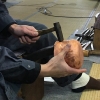As one of Japan’s most important ports, Niigata City has always been synonymous with water. It makes sense then that one of the city’s most recognizable symbols is the indestructible six-arched bridge that spans the Shinano River. For those with a thirst for history—and a good pair of shoes—the Bandai Bridge is the perfect spot for a stroll and a glimpse into Niigata City’s past.
BANDAI’S FIRST GENERATION
During the Meiji period (1868–1912), Niigata City was a booming place to be. Merchant ships sailing between Hokkaido and Osaka called kitamaebune frequently stopped at Niigata Port, and Niigata’s Furumachi district’s geishas were renowned nationwide. Niigata prefecture even boasted the highest population in the entire country! But there was a problem. At that time, Japan’s longest river, the 367-kilometer long Shinano River, cut through the center of the city, making commuting between Niigata Town (present-day Niigata Island) and Nuttari Town (present-day Niigata City’s Chuo Ward) by ferry a bit tricky, especially on days with inclement weather.
Enter our heroes: Uchiyama Shintaro, president of the Niigata Nichiichi Newspaper, and Yagi Tomonao, president of the Daishi National Bank (and future Niigata mayor). Together, they obtained the funding for a wooden bridge that would connect Niigata Town and Nuttari Town, naming it yorozu-bashi, with the character for yorozu (万 ) meaning 10,000 in hopes that the bridge would contribute to the development of Niigata. It was later changed to the current name that we now know, the Bandai Bridge.
Construction started in February of 1886, and the bridge was quickly completed in October that same year. At 782 meters long, it was the longest wooden bridge in Japan at that time, finally providing a way for passersby to cross the Shinano on foot.
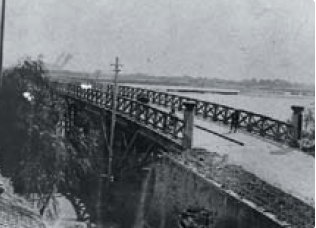
Photo by Niigata National Highway Office(新潟国道事務所)
THE GREAT WAKASAYA FIRE AND THE 2nd GENERATION
As many of the Meiji-period houses in Furumachi’s old town were wooden and not exactly “fireproof”, there was always the risk of a spark leading to big problems. This fear came to fruition in March of 1908 when a fire broke out in a Furumachi geisha house called “Wakasaya”, spreading its flames from road to road, until finally setting the Bandai Bridge ablaze and burning half of it down. After 21 years of faithful service, the Bandai Bridge was suddenly a smoking wreck and indefinitely out of service.
However, a little fire couldn’t keep the good people of Niigata down for too long. Using the remains of the old bridge, the second Bandai Bridge’s reconstruction was immediately underway and was completed the very next year in 1909.
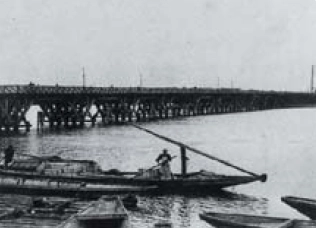
Photo by Niigata National Highway Office(新潟国道事務所)
A NEW NIIGATA AND THE LAST GENERATION
By 1922, the city had experienced some serious changes. Industries were flourishing and its population was growing, bringing with it increased amounts of traffic back and forth across the Shinano River. Rickshaws and horse-drawn carriages were eventually replaced by cars and buses, all which crossed the rickety wooden Bandai Bridge daily. The city couldn’t afford to be without its now-crucial lifeline, so plans were made to ensure the bridge’s survival, complete with a new look.
To enhance its longevity, the new Bandai Bridge would be constructed of reinforced concrete and contain six arches, not only providing a robust design that could withstand earthquakes, but also provide a calming and majestic aesthetic. However, a project of this magnitude would be no small feat, as the entire estimate would be 20% of Niigata City’s budget. Nevertheless, construction began in 1927, and by August of 1929, the 306.9-meter Bandai Bridge was complete, giving us the now-iconic overpass we all know.
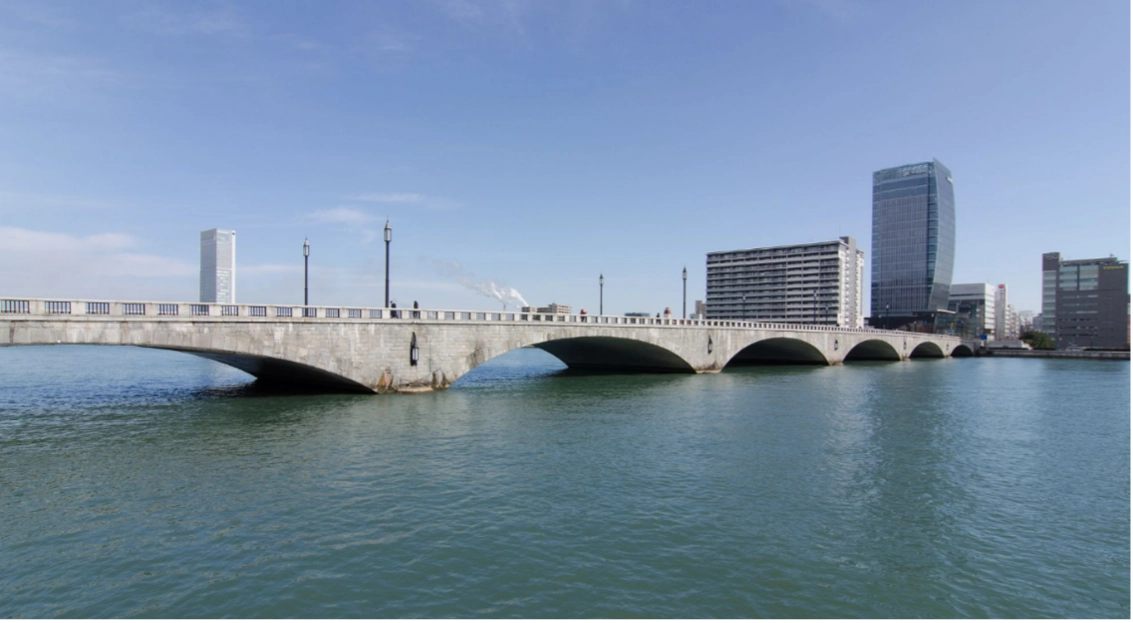 Photo by Enjoy Niigata Official Travel Guide
Photo by Enjoy Niigata Official Travel Guide
THE BANDAI TODAY
Perhaps you’ve passed over it by car or bus, but to really appreciate the impact of this magnificent bridge, walking is the best method. From Niigata Station, head north from the Bandai district towards the Shinano River and continue your journey via the bridge’s pedestrian walkway. On your journey, you’ll encounter the Bandai’s original nameplates, reproductions of the bridge’s original pillars and even artistic odes to the bridge, like a plaque featuring haiku poet Kyoshi Takahama’ s “One thousand two hundred and seventy steps along the Dewy Bridge” and lyricist Hifumi Yamagishi’s “Niigata Blues’’.
While the bridge itself doesn’t change, the views and seasonal activities around it often do. In Spring, the Bandai is lovingly dotted with thousands of flowers for the Tulip Festival, while in Summer during the Niigata Festival, traditional dancers and musicians make their way across a spectacularly illuminated bridge.
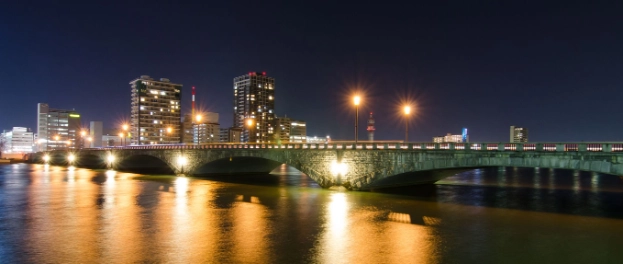
Photo by Enjoy Niigata Official Travel Guide
CONCLUSION
Through fire, earthquakes, and the passage of time, the Bandai Bridge has remained a steadfast symbol of resilience and beauty—always waiting to welcome those who walk its storied path.
 |
Even though Joshua Furr is from North Carolina (home of bluegrass, flight and Pepsi), he prefers a life outside the U.S. Currently you’ll find him in Warsaw, Poland.
He has a beautiful wife and two sons, all whom he forces to listen to Japan-based conversation and 80s music. Around lunch, he dreams about eating gyudon at Sukiya. When he’s not spending time with his family, he’s writing, teaching or tinkering with Adobe software. |









